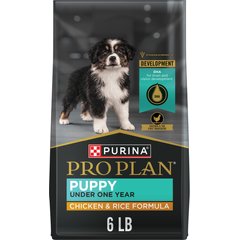How Many Puppies Can a Dog Have?
Andrii Zorii/iStock / Getty Images Plus via Getty Images
As a pet parent, you may be curious about intentionally breeding your dog. Or maybe you’re facing an unexpected dog litter. Whatever the situation is, many questions can spring to mind.
These questions may include:
-
How many puppies can a dog have?
-
How can you tell how many pups to expect?
-
How many litters can a dog have?
In this article, you’ll learn a little more about what to expect if your dog is pregnant.
Pregnancy in Dogs
Dog pregnancy is a short and sweet time for a new mom, with just over two months between the time she is bred and the time she gives birth.
During these 63 days or so, her body will undergo many changes. These include:
-
Weight gain
-
A fuller and longer vulva
-
Mammary gland enlargement to begin milk production
-
Increased calorie and nutrient needs (a mother dog should be fed a diet labeled for growing puppies)
While the timeline for dog pregnancy may be short, it’s important to watch your dog’s health to ensure an uneventful delivery.
As she gets closer to whelping, she may start nesting as she finds a safe place to have the puppies.
How Many Puppies Can a Dog Have?
An average litter can be anywhere from one to 12 puppies, with the average litter size being around four to six puppies. However, litter size varies depending on a mother dog’s:
- Size
- Breed
- Age
- Overall health
- Nutrition
- Genetics
Litter sizes can also vary depending on the season and breeding practices.
Other factors that may impact litter size include the overall health of the mother and her diet.
Smaller breed dogs tend to have smaller litters, while larger breed dogs have larger litters. This makes sense, as there is significantly more space in the uterus of a larger breed of dog.
A big litter is usually considered eight or more puppies, with some dogs having as many as 18 puppies in a litter. However, a litter this large is uncommon.
Smaller litters are those where the dog has three or fewer pups, but it’s all relative to size. A healthy mom may only have one or two puppies if she is very small.
Other factors that may impact litter size include the overall health of the mother and her diet. Ideally, a newly expecting dog should be fed a diet containing enough protein and essential fatty acids she needs for pregnancy support.
This is often done by feeding pregnant dogs commercial diets labeled for puppies.
Healthy moms that are free of disease have larger litters and an easier time getting pregnant. Pregnant dogs who are very young or very old are more likely to have fewer puppies that are more likely to have weaker immune systems.
The season and how your dog gets pregnant can also play a role in litter size. One Scandinavian study suggests dogs bred in the spring may have larger litters on average than those bred in the summer.
Dogs that breed naturally tend to have larger litter sizes than those bred by artificial insemination (AI).
Finally, individual genetics can affect litter size. Some dogs are genetically more likely to have larger litters than others.
Do not overbreed your dog. Overbreeding can be very dangerous.
It’s important if you are starting a breeding program that you prioritize selecting healthy puppies with minimal bad traits (like hip dysplasia, heart defects, poor temperament) above all else.
Responsible breeding means you may not always select for the largest litter.
How Many Litters Does a Dog Have?
Dogs will have a heat cycle every six to seven months on average.
It’s not recommended that a dog be bred more than once a year. She needs time between litters for her uterus to heal and shrink after giving birth.
It’s also recommended that you wait for your dog to have at least two heat cycles before breeding for the first time, with most first-time moms being around 2 years old.
Given these guidelines, most dogs will only responsibly be bred three to four times before retirement.
The breed of your dog may affect this.
Some breeds are unable to have litters without a Cesarean section (c-section) by a veterinarian. These breeds often have large heads and narrow pelvic canals, like the English Bulldog, French Bulldog, and Boston Terrier breeds.
A c-section must be planned, and this is major abdominal surgery. These breeding females are often retired sooner, rather than be put through many surgeries.
Additionally, if your dog had any difficulties with pregnancy, it may be wise to give her more time between litters or possibly not breed her again.
Do not overbreed your dog. Overbreeding can be very dangerous.
While a dog may be able to have 10 litters in her lifetime, this is risky for her and the puppies’ health.
An overbred dog may have more issues with fertility and more problems with nutrition and their immune system. She may be more prone to uterine infections, mastitis, or hypocalcemia (eclampsia).
Additionally, she may develop aggression and behavior issues.
An overbred dog may have puppies born with weakened immune systems and have many bacterial and viral infections as well as parasites.
Can You Tell How Many Puppies a Dog Will Have?
The best way to estimate how many puppies are coming is by getting an X-ray taken of your dog when she is around 45 days pregnant.
Your veterinarian will be able to show you the developing skeletons of the fetuses for you to get an idea of how many pups are on their way.
Sometimes it’s tricky to get an exact count if there is a puppy overlapping another in the image, but X-rays can be very helpful in knowing what to expect.
How Many Puppies Can a Dog Have FAQs
How many puppies can a first-time dog mom have?
First time litters may be smaller than later litters, but the average litter size is four to six puppies.
This number is smaller for small-breed dogs (three to four puppies) and larger for large-breed dogs (six to eight puppies).
Can a dog have 22 puppies at once?
The largest litter of puppies ever reported was 24, according to the Guinness Book of World Records. This litter was born in 2004 by c-section to a Neapolitan Mastiff.
While 22 puppies is possible, it is extremely unlikely. Most breeds' largest reported litter sizes are not more than 15.
Is it normal for a dog to have 10 puppies?
It is not uncommon for large-breed dogs, like German Shepherds and Rottweilers, to have a litter of 10 puppies, although the average is closer to eight.
References
Axnér E, Rasmus LS, Melangen T. Factors affecting reproductive performance in the Swedish Bernese mountain dog. Acta Veterinaria Scandinavica. 2022;64:28. https://doi.org/10.1186/s13028-022-00646
Root Kustritz M. DVM360. Decreased litter size in the bitch (Proceedings). 2009.



